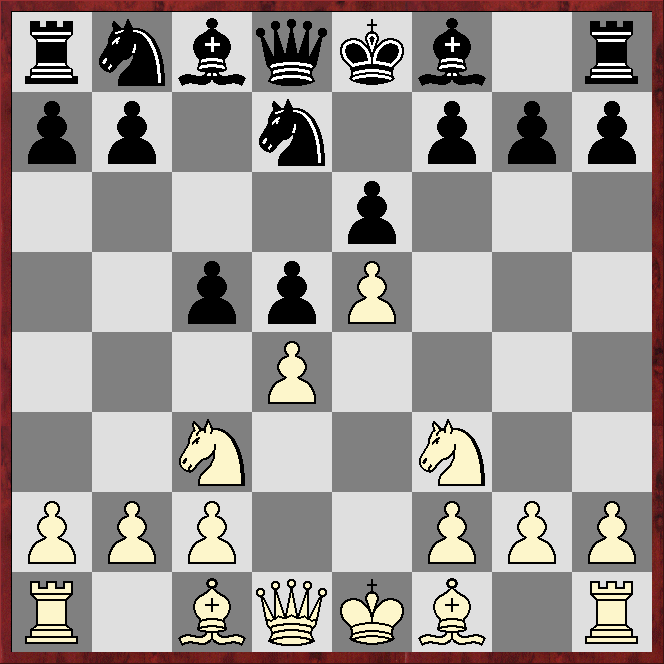The full game can be seen at N7 but here I want to look at a key moment in the opening, which was a Steinitz Variation of the French Defence.
The game began 1.Nc3 d5 2.d4 e6 3.e4 Nf6 4.e5 Nfd7 5.Nf3 c5, reaching a position occurring 7,874 times in ChessBase's 2022 Mega database.
*****
*****
*****
*****
I played 6.dxc5, which occurs 4,908 time in Mega22. That is 62.3% of the time, but is there a reasonable alternative that does not capture away from the centre and helps Black's development?
An obvious try is 6.Be3, which occurs 832 times in Mega22 and has been played by Igors Rausis (2515). The game Rausis - Emmanuel Bricard (2485), Philidor Memorial (Paris) 1995, continued 6..Nc6 7.Bb5 cxd4 8.Nxd4!? Qc7 9.f4 with an equal position, according to Stockfish15 and Komodo13.02 (½–½, 23 moves). But the engines reckon Black has a major improvement in 8...Ndxe5!?, the idea being to meet 9.f4 with 9...a6, eg 10.fxe5 axb5 11.Ncxb5. Now 11...Nxe5 12.Bf4 gives White good play for a pawn, according to the engines, but they reckon Black is at least slightly better after getting on with development by 11...Bd7 or 11...Be7.
The immediate 6.Bb5 occurs 747 times in Mega22 and was a favourite of Georgian grandmaster Bukhuti Gurgenidze, who has 10 games in Mega22, scoring +6=3-1. After 6...Nc6 7.0-0 Gurgenidze's games do not feature 7...cxd4!?, which may be Black's best continuation. The point is 8.Nxd4 again allows 8...Ndxe5!?, when Walter Arencibia Rodríguez (2485) - Alexey Dreev (2570), World Team Championship (Luzern, Switzerland) 1993, saw 9.f4 Nd7 10.f5!? Bc5 11.Bxc6 bxc6 12.fxe6 fxe6 13.Na4 Bxd4+ 14.Qxd4 with at least a tiny pull for White (but 0-1, 44 moves). However the engines reckon 9...a6!? is a major improvement, giving Black a slight edge. Black can also play 7...a6, when Gurgenidze scored three-out-of-three with 8.Bxc6 bxc6 9.Na4, although he did not meet 9...cxd4 10.Qxd4 c5, which Komodo13.02 reckons gives Black a slight edge (Stockfish15 reckons 11.Qg4 equalises).
Developing the other bishop with 6.Bg5 occurs 415 times in Mega22, with Black usually replying 6...Qb6, leading to sharp play. The mainline runs 7.dxc5 Bxc5 8.Qd2, when the greedy 8...Qxb2? is punished by 9.Rb1 Qa3 10.Nb5 Qxa2 11.Nc7+ Kf8 12.Rc1 with Nxa8 to come. Rather than grabbing a pawn Black should probably develop with 8...Nc6, when 9.0-0-0!? ups the ante. After 9...Bxf2!? 10.Na4 Qb4 11.Qxf2 Qxa4 White had reasonable compensation in Dejan Marjanović (2157) - Dragan Kosić (2528), Bosnia & Herzegovina Team Championship (Jahorina) 2012, and went on to split the point despite being massively outrated. Black can also win a pawn by 9...N(either)xe5 10.Nxe5 Nxe5, but 11.Na4 gives good compensation, according to the engines. Perhaps Black's best is 9...Qa5, when the engines suggest the novelty 10.Be3!?, one line running 10...Be7!? 11.Kb1 0-0 12.Qe1!? a6 13.h4 with an unclear position.
The move the engines like most is 6.Ne2!?, which occurs 337 times in Mega22. After 6...Nc6 White can hold the centre with 7.c3, transposing to a mainline position appearing 1,408 times in Mega22. Analysing such a position is outside the scope of this post, but for what it is worth the engines' chief variation continues 7...Be7 8.a3 0-0, which the engines reckon is equal but which scores an excellent 63% for White in Mega22. Black can cut across White's reinforcing plan with 6...cxd4!?, when 7.Nexd4 Nc6 is equal, according to the engines.
CONCLUSION: Siegbert Tarrasch recommended 5.Nf3, rather than the commoner 5.f4, to which he attached a question mark in his 1931 book Das Schachspiel, although as far as I can discover he only played 5.Nf3 once, it an 1892 club match. Over-the-board he usually played 5.f4 before famously giving up on 3.Nc3 in favour of 3.Nd2. After 5...c5 the reply 6.dxc5 is automatic for many players and is certainly what most blacks will expect. But I think the analysis in this post shows White has viable alternatives, even if blacks have little to fear from a theoretical view as long as they avoid risky pawn-grabbing.

No comments:
Post a Comment